“Elevated Expressway should be a futuristic and flawless project”
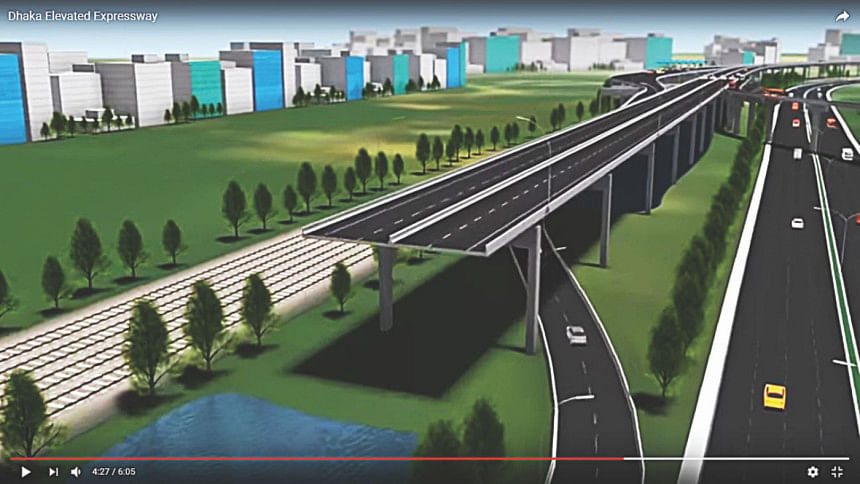
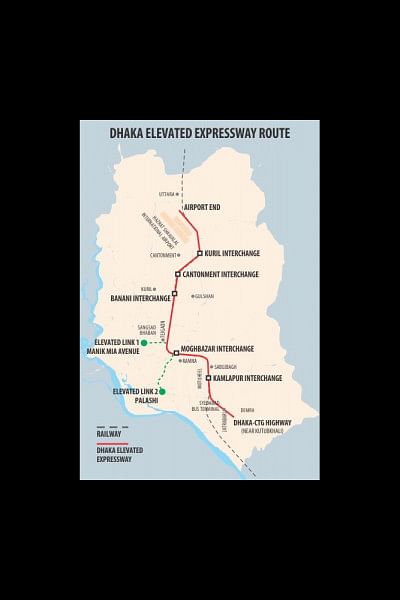
The construction of the first ever elevated expressway project in Dhaka officially commenced on April1, 2018. The main objective of this project is to bypass Dhaka vertically in the fastest possible way, which would significantly reduce the traffic load inside the capital. The Daily Star talks to eminent transportation and safety expert Dr. Md. Shamsul Hoque on various aspects of the project including its unique features, implementation challenges and most importantly, the lessons needed to be learnt from such a mega construction project.
Dr Hoque starts with a brief background of the project. He informs that the idea of Dhaka Elevated Expressway (DEE) was conceived in the STP (Strategic Transport Plan) 2005. In 2010, the Awami League led government resumed the project, targeting the elections in 2014. Dr Hoque joined the expert committee of DEE at that time.
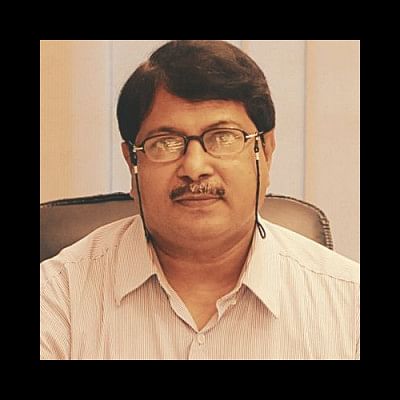
Initially, a pre-feasibility study of DEE was conducted by AECOM, Australia. Although according to STP, the Dhaka Elevated Expressway was supposed to pass through Dhaka, AECOM suggested three alternative routes, all of which fell on the eastern fringe onward Pragati Sarani. The investors, particularly Italian-Thai, urged to take the project through Dhaka to make it lucrative for investment. Two designs (Alignment 4 and Alignment 5) were then proposed, keeping the DEE alignment within Dhaka. The most lucrative design was thought to be Alignment 5 along the existing railway line inside Dhaka, as it would save land and the project could be implemented faster. But it excluded the people-friendly MRT (Mass Rapid Transit) 4. The expert committee, comprised of Dr Jamilur Reza Chowdhury, Dr Mohammad Rahmatullah and Dr Md. Shamsul Hoque, seriously objected to this plan. The government addressed the expert committee's concern by including MRT4 in the DEE plan. Later, two elevated links were added to the DEE connecting Manik Mia Avenue and Old Dhaka, and Alignment 5A was finalized for tender. Italian-Thai Development Public Company Ltd won the bidding.
The implementation modality of DEE is Public Private Partnership (PPP). “The beauty of PPP is its time-boundedness. Unlike government projects, PPP projects must be completed within its stipulated time. Regular maintenance of the infrastructure is also an in-built feature of PPP, which government-run projects seriously lack,” says Dr Hoque.
Unique features of DEE
“We designed DEE as a suspended terminee, which means both ends of the project will not touch down, and further extension of the expressway can be done in the future. Work on the Dhaka-Ashulia elevated expressway will begin from the airport end of DEE and reach Bipile, Savar. There, again, it will be kept suspended. If necessary, we can extend it to the northern areas of the country,” Professor Shamsul Hoque adds.
Safety audit is an in-built feature of the project. Before construction of any section of DEE a safety audit will be conducted by a third-party organisation. A weighbridge will be constructed at the mouth of every ramp to check overloaded vehicles, thereby ensuring longevity of the construction.
Along the DEE corridor, starting after Banani-Mohakhali to Khilgaon Flyover, portal piers will be used instead of single piers. “Although the cost of construction would rise, I managed to convince Italian-Thai Company to use portal piers so that the project can be saved from derailment related hazards, and right of way for future rail projects such as MRT4 can be retained,” shares Dr Hoque.
Minimum traffic is part of the sovereign guarantees given by the host government, which stipulates that if on a single day a certain number of cars doesn't pass over an infrastructure, the government will compensate the private partner. In the case of Mayor Hanif Flyover, for example, the minimum guaranteed traffic is 42,000 cars per day, a target that is not being met. “Based on a background study conducted by BUET, we fixed 14,500 cars per day as the minimum guaranteed traffic for DEE,” informs the expert.
He further adds that one percent of the project cost will be kept aside for establishing the Institute of Civil Engineering and Management, which will create human resources for all the ongoing and future mega structures, including a deep seaport, nuclear plant and so on.
An incentive clause is added in the concessionaire agreement which stipulates that if the contractor completes the construction work before 42 months, they will be able to open the structure for public use and collect toll from it. “Contractors should be treated as the partner, and not the villain, of a project. We often formulate clauses to check contractors, but the reality is that after the beginning of a construction, a contractor cannot be terminated without it impacting the project,” says Dr Hoque. In our present culture, a contractor often takes benefit of any delay, such as a delay in land acquisition, of a project caused by the government. But if they were given the incentive for early completion, contractors would help the government to solve the land crisis. It would also drive growth of advanced construction technologies and high performing construction equipment, adds the expert.
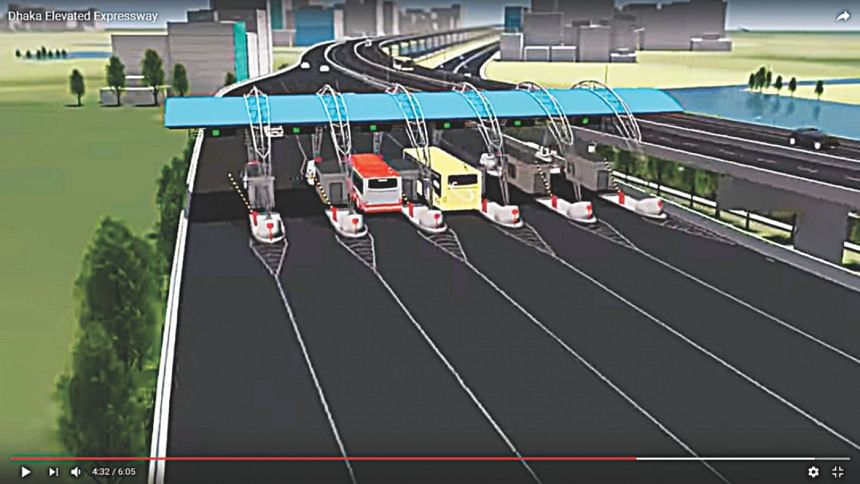
Challenges and concerns
Professor Hoque highlights land acquisition as the main challenge for implementation of the DEE project.
The Rail ministry has yet not given permission to the DEE to use the route along the Internal Container Depot. There is no space for installing piers for DEE near the Khilgaon level crossing. There are also severe challenges in the part of Trans 2 and Trans 3 near Hanif Flyover, as there is no space for installing piers. The Hanif flyover project itself has taken away two-third space of the area.
According to the concessionaire agreement of DEE, the project has to be completed within 42 months of its initiation. The government now has to complete land acquisition and utility shifting in a timely manner. Otherwise, it has to incur huge loss as compensation to the private partner, informs Dr Hoque.
He further adds that the government has unilaterally taken several new projects, such as MRT5 and Mouchak-Moghbazar Flyover, after awarding DEE, which will adversely affect the project. Moreover, the decision to cut off two links (Manik Mia Avenue and Palashi) and shifting of CCB (Central Control Building) from Panthakunja will make the DEE less feasible and less productive. In the PPP agreement, the government guarantees that it will not set up any project that will divert the traffic of a PPP project. But the alignment of DEE shows that it will affect the traffic of Mayor Hanif Flyover, which might create risks of litigation by the Hanif Flyover authority.
Professor Hoque shares another concern about the pillars of DEE looking thinner than usual. A study conducted by BUET found this concern valid. BUET has also proposed independent spot check- ups of the project.
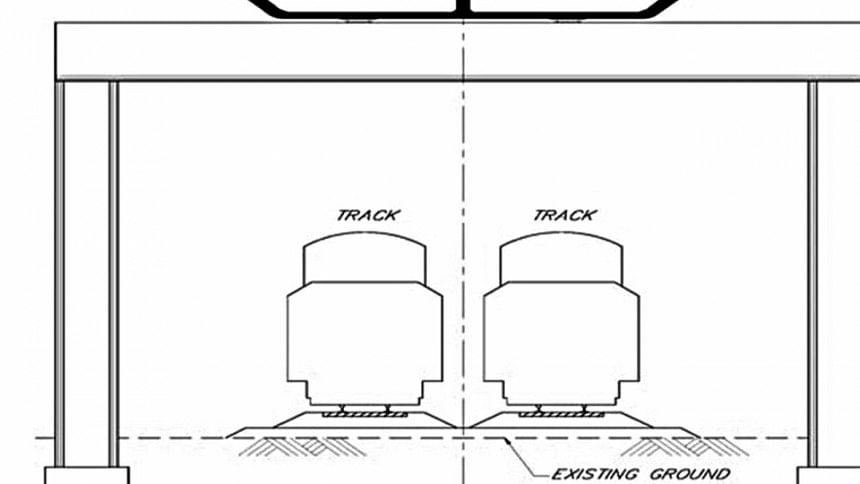
Lessons need to be learnt
Referring to the long delay at the beginning of the construction of the DEE project, Professor Hoque stresses that PPP projects should always be green field projects, so that land acquisition and utility relocation do not cause any hindrance. According to the concessionaire agreement, he argues, while the government cannot take any decision without informing the private partner, it is committing this mistake in the case of the Dhaka Elevated Expressway. This can send a wrong signal that after investing in our country, the agreement can be altered without any discussion with the investor. As this a joint venture the government should take all the project related decisions through its PPP cell, and keep the private partner in the loop, opines Professor Hoque.
He urges the government to come out of its traditional bureaucratic mindset and create an enabling environment for implementing PPP projects. While citing the example of India, Professor Hoque argues that the Indian government is even helping investors get funding through infrastructure bonds. It also checks the outflow of dollar.
Integration among all the infrastructure projects must be ensured, Professor Hoque adds. The Dhaka Transport Coordination Authority was supposed to do this job, but they are failing to implement it. As the Dhaka Elevated Expressway will start near the Hazrat Shahjalal International Airport, there is a great opportunity to connect the Airport with DEE. It will function as an airport-bound expressway through which people can reach Banani within seven to eight minutes, bypassing the traffic.
Professor Hoque concludes with the hope that the government will fully abide by the concessionaire agreement and provide all necessary support to complete the project within the stipulated time. Otherwise, on the one hand, the government will have to incur huge losses to pay damages to the private partner of the project, while on the other, it will send a wrong signal to global investors interested in investing in Bangladeshi projects.

 For all latest news, follow The Daily Star's Google News channel.
For all latest news, follow The Daily Star's Google News channel. 



Comments